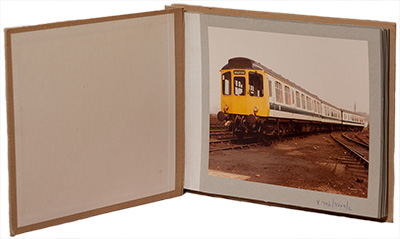Class 110 BRC&W 3-car DMUs
Refurbishment
Being one of the newest types of sets, refurbishment didn't start until late in the programme. First vehicle done was 51843, outshopped in July 1979, after 2 1/2 years in Doncaster following collision damage. The final one was 52081, exactly four years later in July 1983, and three months after its partner, 52072.
Only the first three refurbished Class 110 sets would receive the white/blue stripe livery, the remainder would be blue/grey.
As with most DMUs the refurbishment was carried out in accordance with the BR Director of Industrial Designs Schedule 10. First class seats were reupholstered in a check brown moquette, and the second class in the universal blue/green pattern. Armrests and headrests were re-covered in matching plain vinyl. New orange and ginger carpets were also provided in the first class. First class saloon walls were panelled sand melamine, but second class retained the original pale-green panelling, except if this had been damaged or taken out for asbestos removal. Second class partition walls and doors were resurfaced, or painted blue as appropriate. Fluorescent lighting replaced the tungsten originals. Toilet and guards compartments were also given a facelift, driving cabs repainted and the drivers seat recovered. All surviving vehicles except three trailers were refurbished.

Photograph Album
The following images are from an internal British Rail photograph album that recorded the refurbished sets.
The majority of the views record a set in a yard with the DMCL identified as E51832, the interior views were also taken outside and so are thought to be the same set, a cab view is of DMBC E51819 which was 51832's partner when refurbished, and so the centre car is presumed to be E59811.
The images are presented here in the order they were included in the album, although not sequential in the order they were taken in terms of the negative numbers. The final negative numerically shows a different set inside the shed, with DMBC E51816. The works dates on vehicle that are February 1979, so these were taken after that date, thought to be circa June 1979, all vehicles have spent time in traffic since the work was done.
The exterior views were possibly taken at their home depot, Bradford Hammerton Street, the image inside the shed could be Neville Hill — compare with this view. Or were all the images taken at Neville Hill? If anyone with knowledge of either place can recognise them that would be useful.

Negative Y. 796/3249/8
The padding fitted under the drivers desk. The small white label above the centre window tells is this is DMBC E51819.

Negative Y. 796/3249/9
The first class compartment in a DMBC. This one was non-smoking, the other in the DMCL was for the smokers.

Negative Y. 796/3249/14
The rear half of a DMCL. This view would be very similar for a DMCL and a TSL. One difference (ignoring the floor hatch) is the seat layout in the centre saloon as the two and three seaters are switched. If this was the TSL for the row of seats closest to the camera the three seater would be on the left.

Negative Y. 796/3249/12
The rear saloon in a TSL. looking towards the toilet end. While the original tungsten main saloon lighting has been replaced by fluorescents, the small 'bulls eye' tungsten lighting remains on the lowered (to hold a water tank above) ceiling outside the toilet. Compare with toilet end of the DMCL (the 10th image, negative Y. 796/3249/14) and the placement of the centre lights is different, and the formica in the bulkhead facing us is split in two on this vehicle.
Vehicle Details
All Class 110 refurbishments were done at Doncaster Works, and the table below shows the Works date and the livery applied. Information supplied by Eddie Knorn extracted from the BR record cards for each vehicle.


Mixed livery sets were not uncommon in this period. Here a set with each vehicle in a different livery is seen at Penistone with a Sheffield to Huddersfield (and Leeds?) train on Tuesday 14-10-80. John Atkinson.
Summary
Description
Interior
Problems and Alterations
Diagrams & Works Photos
Numbering & Driving Instructions
Liveries
Refurbishment
Operations
Accidents
Non-Passenger Use
Images
Details about preserved Class 110s can be found here.
















